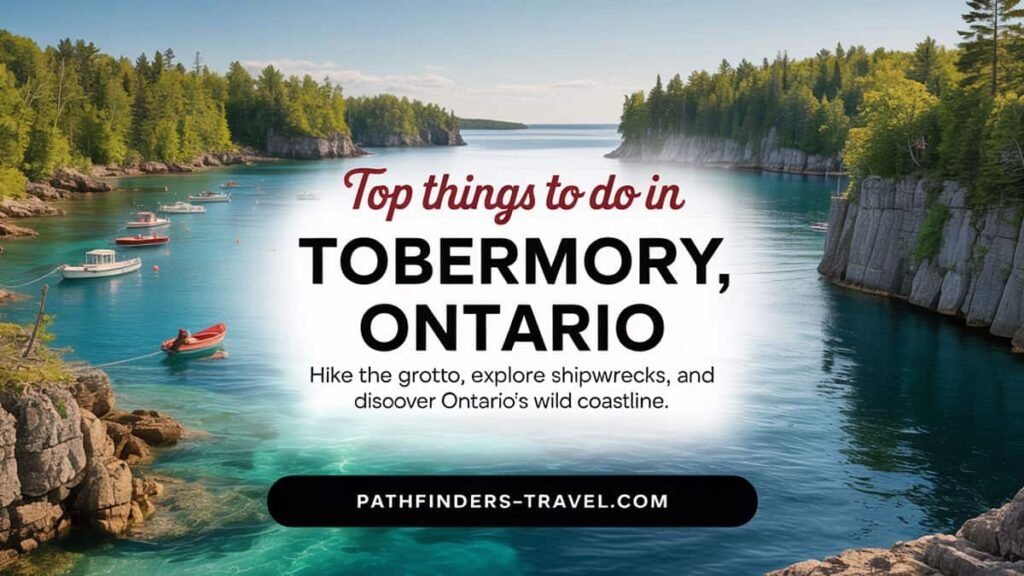Estimated reading time: 18 minutes
Last Modified Date: 20/10/2025
Key Takeaways
- Tobermory offers stunning natural beauty with crystal-clear turquoise waters and limestone cliffs.
- The Bruce Trail provides access to amazing hiking opportunities, including The Grotto, one of Ontario’s most photographed natural attractions.
- Fathom Five National Marine Park features 22 shipwrecks that can be explored through glass-bottom boat tours.
- Big Tub Harbour has some of the clearest waters in the Great Lakes, allowing visitors to see shipwrecks from the surface.
- Plan ahead for parking passes at Bruce Peninsula National Park, especially during peak summer months.
Table of Contents
- Introduction
- Overview of Tobermory and the Bruce Peninsula Region
- Hiking Adventures on the Bruce Trail
- Exploring The Grotto in Bruce Peninsula National Park
- Water-Based Exploration & Historical Shipwreck Tours
- Discovering Big Tub Harbour
- Itinerary & Travel Tips for the Adventure-Focused Trip
- Frequently Asked Questions about Visiting Tobermory and the Bruce Peninsula
- Conclusion
Introduction
Top Things to Do in Tobermory
Located at the tip of the Bruce Peninsula, Tobermory is a hidden gem in Ontario that attracts nature lovers and adventure seekers from all over. This charming harbor town offers a perfect blend of outdoor activities, natural wonders, and historical sites. With its crystal-clear turquoise waters that rival Caribbean beaches and rugged limestone cliffs, Tobermory provides a picturesque backdrop for unforgettable adventures.
Whether you want to hike along scenic trails, explore underwater shipwrecks, or simply relax by pristine harbors, Tobermory has something for everyone. This guide will take you through the best experiences this magnificent destination has to offer, including hiking the Bruce Trail, discovering The Grotto, embarking on shipwreck tours, and enjoying the charm of Big Tub Harbour.
Want to explore more of Ontario’s incredible landscapes? Visit the Pathfinders Travel YouTube Channel to watch other Wonders of Ontario in stunning 4K UHD resolution.
Overview of Tobermory and the Bruce Peninsula National Park Region
Nestled at the northern tip of the Bruce Peninsula, Tobermory serves as a gateway to some of Ontario’s most stunning natural attractions. The town itself is relatively small, consisting of just a few streets wrapped around two harbors, but those harbors hold some of the clearest water in the Great Lakes. You can actually stand on the dock and count individual rocks on the bottom 40 feet down! [SOURCE]
The Bruce Peninsula is a remarkable stretch of land that separates Georgian Bay from Lake Huron. It’s home to Bruce Peninsula National Park, a natural paradise covering 60 square miles of cliff, forest, and shoreline. The Niagara Escarpment runs through the park, creating dramatic 400-million-year-old limestone cliffs that drop straight into the turquoise waters of Georgian Bay. [SOURCE]
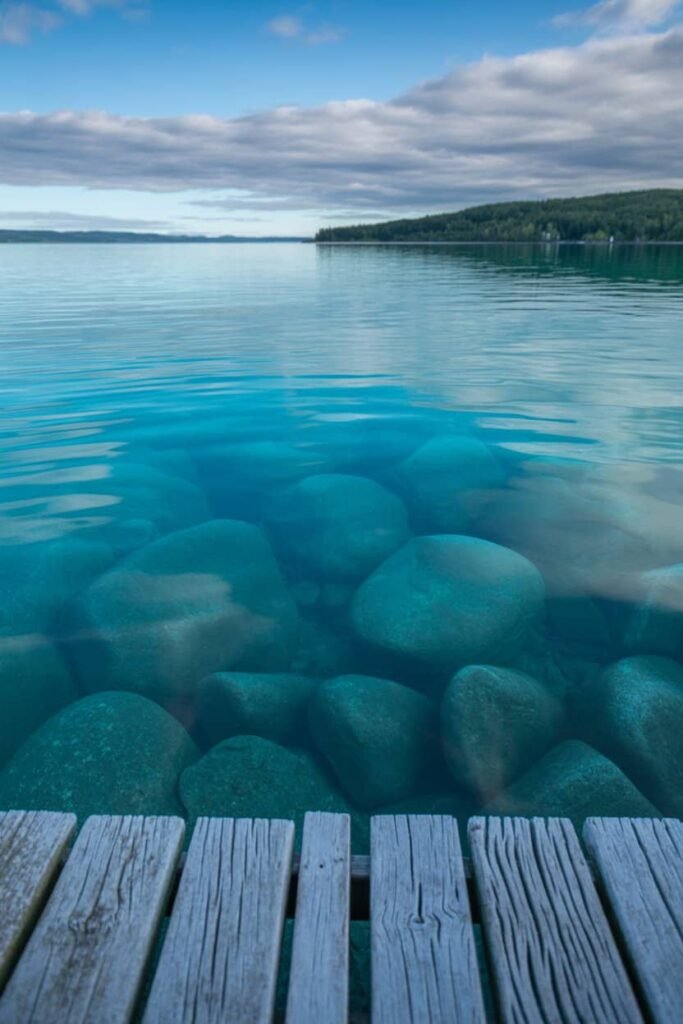
What makes this region truly unique is its remarkable geological features. The peninsula was formed by ancient tropical seas that created the limestone bedrock, which was later shaped by glacial activity. This geological history has resulted in fascinating formations like caves, sinkholes, and alvars (rare limestone plain habitats).
The waters around Tobermory stay exceptionally clear because they’re quite cold – even in August, the temperature rarely climbs above 60°F. This clarity, combined with the historical significance of the area, has made Tobermory a hub for outdoor enthusiasts and nature photographers.
Hiking the Bruce Trail on the Bruce Peninsula
Guide to Hiking the Bruce Trail
The Bruce Trail is Canada’s oldest and longest marked footpath, stretching approximately 550 miles from Niagara to Tobermory. The northern section that runs through the Bruce Peninsula offers some of the most scenic views along the entire route. This portion of the trail takes hikers along the edge of the Niagara Escarpment, providing breathtaking vistas of Georgian Bay’s turquoise waters. [SOURCE]
For those planning to hike the Bruce Trail near Tobermory, here are some helpful tips:
- Trail Difficulty: The terrain can be challenging in places with steep climbs, rocky sections, and slippery surfaces, especially after rain. Wear appropriate hiking boots with good traction.
- Water and Supplies: Bring plenty of water as there are limited facilities once you’re on the trail. Pack snacks, sunscreen, insect repellent, and a first-aid kit.
- Navigation: While the main Bruce Trail is marked with white blazes, side trails (marked with blue blazes) often lead to lookouts and points of interest. Consider purchasing a trail map from the Bruce Trail Conservancy.
- Timing: Allow more time than you think you’ll need, as the rugged terrain often slows hiking pace.
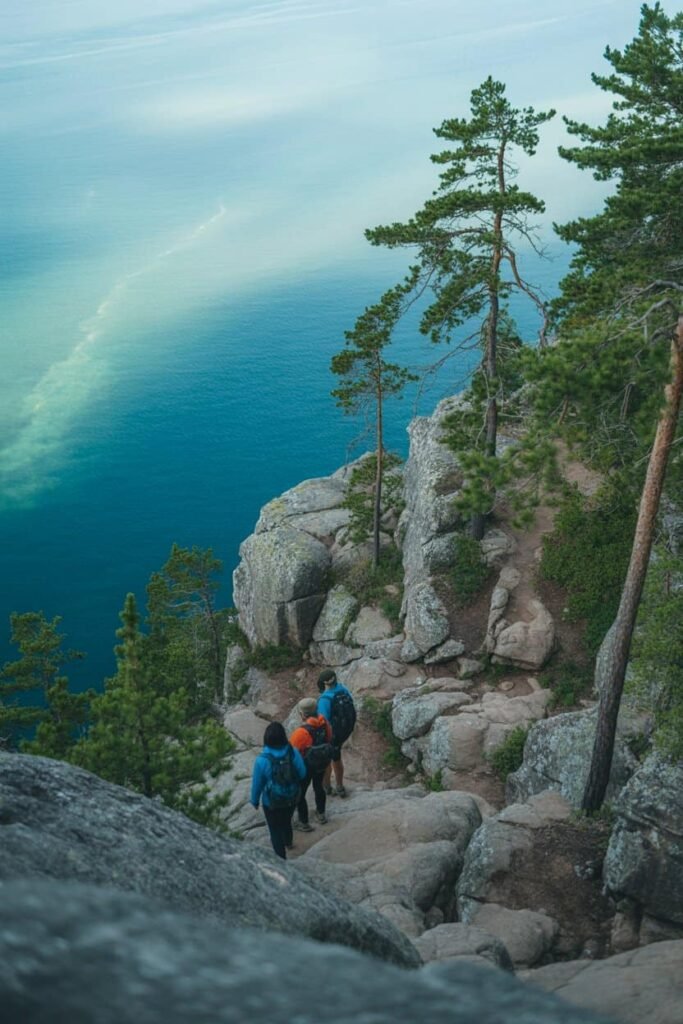
The coastal trail portion runs along the edge of the Niagara Escarpment where the ancient rock drops straight into Georgian Bay. In some sections, the trail passes through forests so thick the ground stays dark at midday, while in others, you’ll walk on bare limestone following cairns across almost moon-like terrain.
Hiking to The Grotto in Bruce Peninsula National Park
Perhaps the most popular hiking destination in the area is The Grotto, a stunning natural sea cave carved into the limestone cliffs of Bruce Peninsula National Park. The journey to this natural wonder is as rewarding as the destination itself. [SOURCE]
The hike to The Grotto begins at the Cyprus Lake parking area within Bruce Peninsula National Park. From there, you can take the Georgian Bay Trail, which is about a 1.5-hour round trip hike. Along the way, you’ll pass through beautiful cedar forests, across ancient limestone formations, and past stunning shoreline vistas that showcase the peninsula’s diverse ecosystems.
As you approach The Grotto, you’ll first encounter Indian Head Cove, a beautiful natural bay with crystal-clear water that’s perfect for swimming on warm summer days. Just a short walk further is The Grotto itself – a magical sea cave where sunlight filters through an underwater entrance, creating an ethereal blue glow in the water within. [SOURCE]
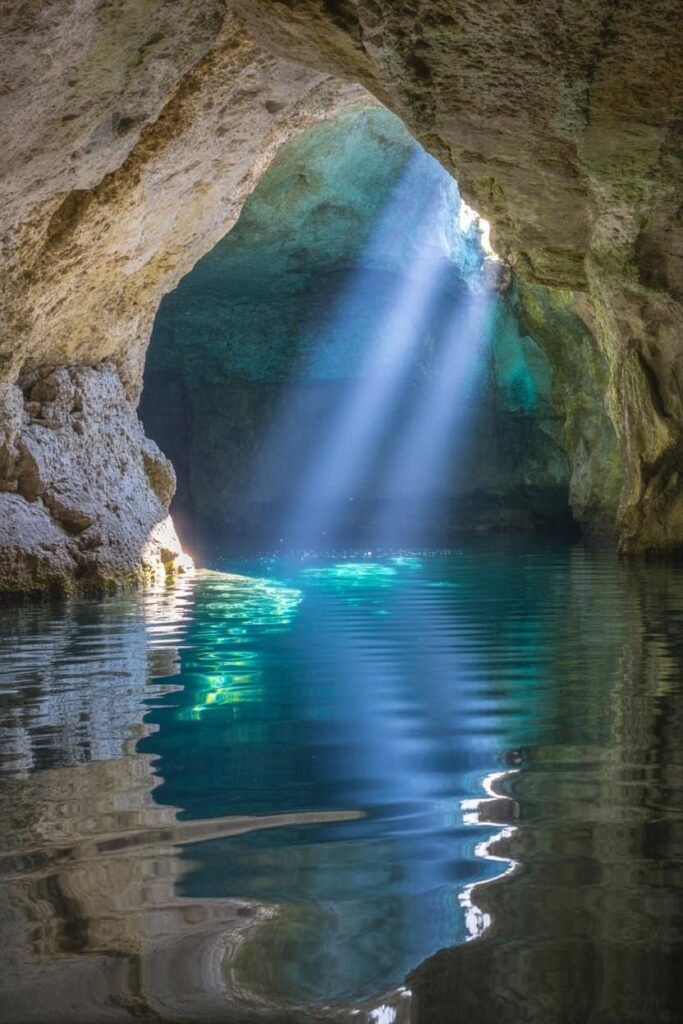
What to bring when hiking to The Grotto:
- Sturdy footwear: The final approach involves climbing down rocky terrain
- Swimwear: If you plan to take a dip in the refreshing (but cold!) waters
- Camera: The views are truly spectacular
- Layers: The temperature near the water can be significantly cooler
- Water bottle: Stay hydrated throughout your hike
Remember that visiting natural attractions like The Grotto requires proper preparation. The final approach involves scrambling down loose rocks and squeezing through gaps in the cliff face, which may be challenging for those with limited mobility or young children.
Exploring The Grotto Sea Cave in Bruce Peninsula National Park
Natural Formation and History
The Grotto is one of Ontario’s most photographed natural features, and for good reason. This remarkable sea cave formed when waves found a weak spot in the Dolomite cliffs and gradually carved inward over thousands of years. The result is a large cave chamber that’s partially filled with water that glows an incredible blue-green color when sunlight enters through an underwater opening. [SOURCE]
Geologically speaking, The Grotto sits within the ancient Niagara Escarpment, a UNESCO World Biosphere Reserve. The rocks that form the cave are approximately 400 million years old, created when this area was covered by a tropical sea. Over time, the limestone has been shaped by both glacial activity and the persistent action of water, creating the unique formation we see today.
The Grotto holds cultural significance as well. The area has been important to Indigenous peoples for thousands of years. The Saugeen Ojibway First Nation has deep connections to this land, which contains many sacred sites and has been part of their traditional territory since time immemorial.
Practical Advice
Visiting The Grotto requires some planning, especially during the busy summer season. Here’s what you need to know:
- Parking Reservations: From May through October, advance parking reservations are mandatory. These can be booked through the Parks Canada reservation system, and each reservation provides a 4-hour time slot. Reservations often fill up months in advance for peak summer weekends. [SOURCE]
- Best Time to Visit: Early morning or late afternoon time slots typically offer more tranquility. The lighting for photography is also better during these times.
- Physical Requirements: The final descent to The Grotto requires climbing down through a crevice in the rocks. This can be physically demanding and isn’t suitable for everyone.
- Swimming Safety: If you plan to swim in The Grotto, be aware that the water is very cold, even in summer. There are no lifeguards, so swim at your own risk and never swim alone.
- Leave No Trace: This fragile ecosystem deserves protection. Take only photos and leave only footprints.
For those who may find the scramble down to The Grotto too challenging, the lookout points along the trail still offer spectacular views of Georgian Bay and the surrounding cliffs. Don’t be disappointed if you can’t make it all the way down – the journey itself provides plenty of natural beauty to enjoy.
Fathom Five National Marine Park Shipwreck Tours and Water Adventures
Fathom Five National Marine Park Shipwreck Tours
Just offshore from Tobermory lies Fathom Five National Marine Park, Canada’s first national marine conservation area. This underwater park protects 22 known shipwrecks, many of which date back to the 19th and early 20th centuries when sailing vessels navigated these waters without modern navigation equipment. [SOURCE]
The exceptional water clarity makes Tobermory one of the best freshwater diving destinations in the world. For non-divers, glass-bottom boat tours provide an accessible way to explore these underwater time capsules. These tours typically depart from Little Tub Harbour and visit several of the shallower wrecks.
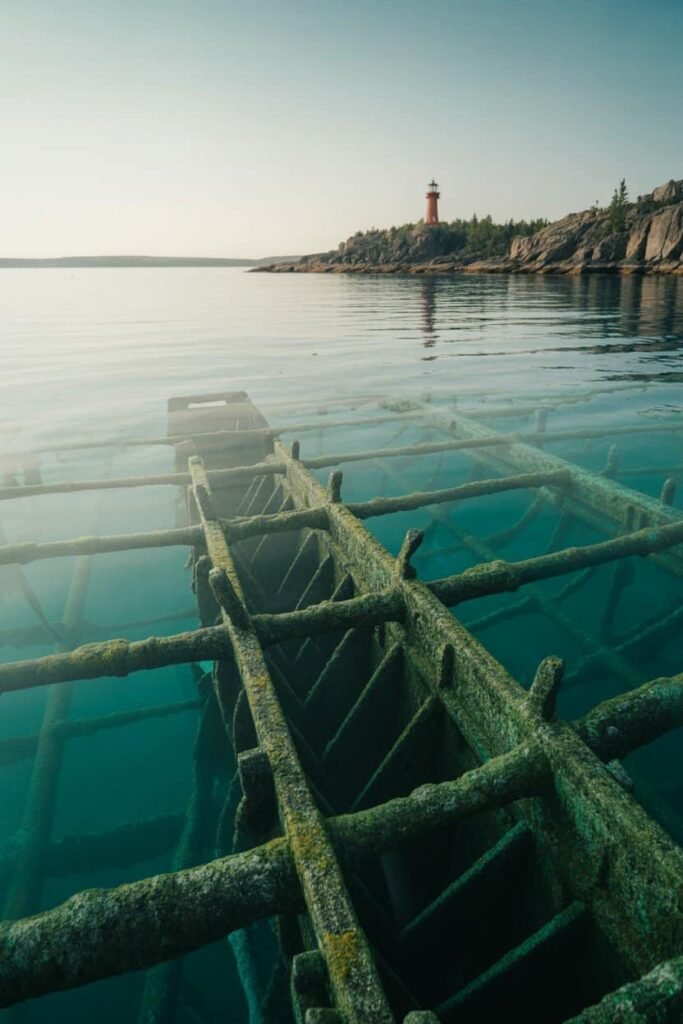
Some of the most notable shipwrecks you can see include:
- Sweepstakes: A two-masted schooner that sank in 1885, now resting in just 20 feet of water in Big Tub Harbour. The wooden hull has turned black with age, but the deck planking, ribs, and structure remain remarkably intact.
- City of Grand Rapids: A passenger steamer that burned and sank in 1907, now resting near Sweepstakes in shallow water.
- Arabia: A two-masted schooner that sank in 1884 after striking a reef. It rests in about 100 feet of water but is visible from glass-bottom boats.
- Forest City: This steamer ran aground in 1904 and now sits in shallow water near Russell Island.
Most tour companies operate from May to October, with peak season being July and August. Tours typically last between 1.5 to 2.5 hours, depending on the itinerary. Many tours also visit Flowerpot Island, famous for its natural stone pillars that resemble flowerpots.
Significance of the Shipwrecks
The shipwrecks of Fathom Five National Marine Park aren’t just interesting attractions; they’re important historical artifacts that tell the story of Great Lakes maritime history. These vessels represent an era when sailing ships and early steamers were the primary means of transportation and commerce in the Great Lakes region. [SOURCE]
Many of the ships sank due to the challenging navigation conditions around the Bruce Peninsula. The area was notorious for sudden storms and hidden shoals that could spell disaster for vessels, especially before modern navigation aids. Each wreck has its own story – some were caught in storms, others struck reefs or caught fire.
The cold, fresh water of Georgian Bay has preserved these wooden wrecks remarkably well. Unlike saltwater environments, where marine organisms quickly break down wooden structures, the shipwrecks in Fathom Five can remain intact for centuries. This preservation allows visitors to see details that would be long gone in ocean environments.
For history buffs, these shipwrecks provide a tangible connection to the past and insight into 19th-century shipbuilding techniques. For adventure seekers, they offer a chance to explore underwater museums frozen in time.
Visit nearby Manitoulin Island to extend your Great Lakes adventure and explore the world’s largest freshwater island, just a ferry ride away from Tobermory.
Exploring Big Tub Harbour and Coastal Highlights
Exploring Big Tub Harbour
Big Tub Harbour got its name from its round shape and steep sides, creating a natural basin that resembles a large tub. This protected harbor is one of Tobermory’s main attractions and offers some of the clearest water you’ll find anywhere in the Great Lakes region. [SOURCE]
The harbor serves both as a marina for pleasure boats and as the departure point for many of the glass-bottom tour vessels that cruise over the nearby shipwrecks. Its sheltered waters and exceptional clarity make it an ideal spot for viewing the famous Sweepstakes and City of Grand Rapids shipwrecks, which lie just beneath the surface.
Beyond the shipwrecks, Big Tub Harbour offers several attractions and activities:
- Big Tub Lighthouse: Built in 1885, this charming white lighthouse stands at the harbor entrance. Visitors can walk around the grounds and enjoy beautiful views of Georgian Bay.
- Swimming and Snorkeling: The crystal-clear waters are perfect for a refreshing dip, though be prepared for cold temperatures even in summer. Snorkeling over the shallow shipwrecks offers an unforgettable experience.
- Dining: Several restaurants near the harbor offer fresh local fish and other specialties with waterfront views.
- Sunset Watching: Big Tub Harbour faces west, making it one of the best spots in Tobermory to watch the sun sink into Georgian Bay.
The harbor area is relatively small and can get quite busy during peak summer months. Arriving early in the morning or later in the afternoon can provide a more peaceful experience. Parking is limited near the harbor itself, so be prepared to walk a short distance if visiting during high season.
One of the best ways to experience Big Tub Harbour is simply to find a quiet spot along the shoreline, perhaps on one of the large rocks that line parts of the harbor, and spend some time taking in the scenery. The combination of clear blue water, historic shipwrecks, and the coming and going of boats creates a tranquil yet fascinating atmosphere that captures the essence of Tobermory.
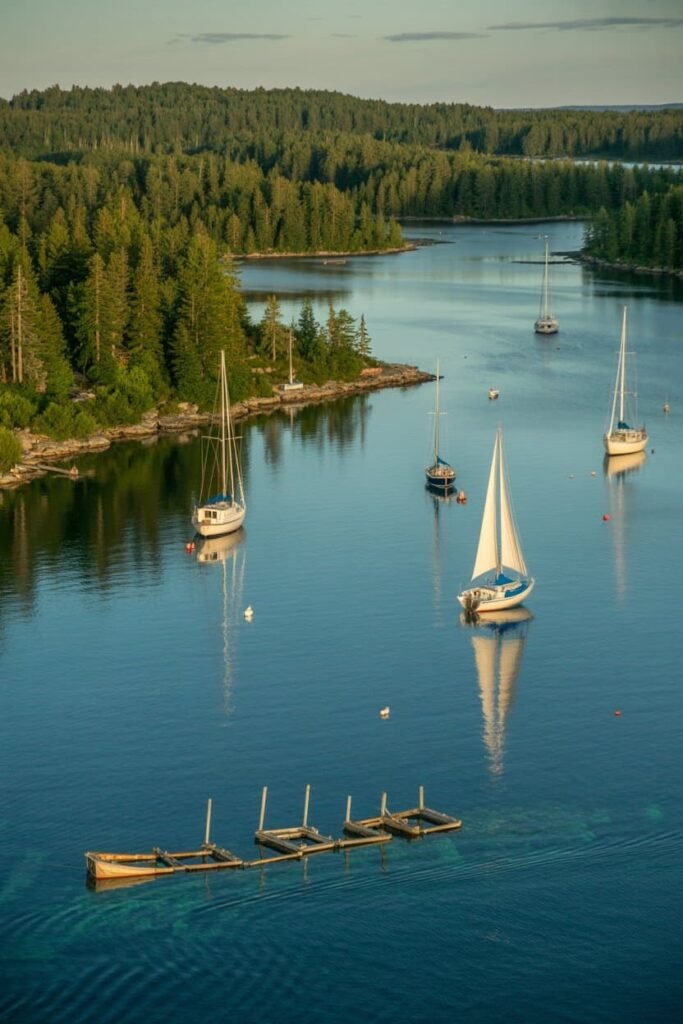
If you’re interested in other geological wonders in Ontario, the contrast between Big Tub Harbour’s clear waters and other unique formations across the province provides a fascinating study in the region’s diverse natural landscape.
3-Day Tobermory Itinerary and Bruce Peninsula Travel Tips
Planning an adventure-focused trip to Tobermory requires some strategy, especially during the busy summer season. Here’s a suggested 3-day itinerary that combines all the must-see attractions while avoiding the worst of the crowds:
Day 1: Bruce Peninsula National Park and The Grotto
- Morning (8:00 AM – 12:00 PM): Begin your day early with your reserved parking pass for Bruce Peninsula National Park. Take the trail to The Grotto while the morning light is perfect for photography and before the midday crowds arrive.
- Lunch: Enjoy a picnic lunch at a designated area within the park or head back to Tobermory for a meal at one of the local eateries.
- Afternoon (2:00 PM – 6:00 PM): Explore other trails within Bruce Peninsula National Park, such as the Marr Lake Trail or parts of the Bruce Trail near Little Cove.
- Evening: Dine in Tobermory and take a sunset stroll along Little Tub Harbour.
Day 2: Shipwreck Tours and Flowerpot Island
- Morning (9:00 AM – 12:00 PM): Take a glass-bottom boat tour to see the shipwrecks of Fathom Five National Marine Park. Most tours last approximately 2-3 hours.
- Afternoon (12:30 PM – 5:00 PM): Many boat tours include a stop at Flowerpot Island. Spend the afternoon hiking the island’s trails and seeing its famous rock formations.
- Evening: Return to Tobermory for dinner. Consider trying some fresh local whitefish at a waterfront restaurant.
Day 3: Big Tub Harbour and Coastal Exploration
- Morning (9:00 AM – 11:00 AM): Visit Big Tub Harbour and the Big Tub Lighthouse. If the water is calm, bring snorkel gear to view the shipwrecks from the surface.
- Midday (11:30 AM – 2:00 PM): Have lunch in town, then visit the Parks Canada Visitor Centre to learn more about the region’s natural and maritime history.
- Afternoon (2:30 PM – 6:00 PM): Explore the coastal section of the Bruce Trail near Tobermory for stunning views of Georgian Bay.
- Evening: Enjoy a farewell dinner and perhaps catch one last sunset before departing.
Essential Travel Tips:
- Reservations: Book everything well in advance, especially during peak season (July-August):
- Accommodation in Tobermory (hotels, B&Bs, or campgrounds)
- Parking passes for Bruce Peninsula National Park
- Boat tours to see shipwrecks and Flowerpot Island
- Timing: Consider visiting in June or September to avoid peak crowds while still enjoying good weather.
- Weather Preparation: Weather on the peninsula can change quickly. Bring layers, rain gear, and sun protection.
- Cell Service: Cell phone reception can be spotty in parts of the peninsula. Download maps and information in advance.
- Wildlife Awareness: The Bruce Peninsula is home to black bears and other wildlife. Store food securely if camping and keep a safe distance from all wild animals.
- Water Temperature: Even in summer, the water in Georgian Bay stays quite cold. If planning to swim, consider bringing a wetsuit or limiting your time in the water.
- Leave No Trace: Help preserve this beautiful area by packing out all trash and staying on marked trails.
This itinerary balances popular attractions with some less-visited spots to give you a comprehensive Tobermory experience. The schedule allows flexibility for weather changes or unexpected discoveries along the way. If you have extra time, consider adding a day trip to Hamilton’s spectacular waterfalls, which are located a few hours’ drive south of Tobermory.
Frequently Asked Questions about Visiting Tobermory and the Bruce Peninsula
When is the best time to visit Tobermory and the Bruce Peninsula National Park?
The best time to visit Tobermory and the Bruce Peninsula National Park is from early July through early September, when the weather is warm, hiking trails are open, and boat tours to Flowerpot Island and the shipwrecks are in full operation.
What should I book in advance for Tobermory and Bruce Peninsula National Park?
It’s important to reserve your Bruce Peninsula National Park parking pass, Fathom Five Marine Park shipwreck or glass-bottom boat tours, and local accommodations early—especially between July and August when visitor demand peaks.
What should I pack for hiking the Bruce Trail and exploring Tobermory’s waters?
Bring sturdy hiking boots for rocky trails, layered clothing for variable weather, and swimwear or a wetsuit for cold-water snorkeling and kayaking. Sunscreen, insect repellent, and plenty of water are essential for both hiking and shoreline activities.
Are there any safety or access tips for Bruce Peninsula National Park and Tobermory?
Highway 6 can get busy during summer, and cliff areas near The Grotto require careful footing. Always stay on marked trails, avoid cliff edges, and store food securely if camping, as black bears and other wildlife are occasionally present.
How can I plan a 3-day Tobermory and Bruce Peninsula itinerary efficiently?
A balanced 3-day plan includes hiking to The Grotto, exploring Fathom Five’s shipwrecks, and relaxing at Big Tub Harbour. Booking key passes in advance and visiting during late spring or early fall ensures a smoother, less crowded experience.
Conclusion
Tobermory and the Bruce Peninsula combine breathtaking geological landscapes with rich maritime history, making them one of Ontario’s most rewarding destinations for outdoor exploration. Whether you’re hiking rugged trails, discovering underwater shipwrecks, or enjoying the peaceful views at Big Tub Harbour, every experience here connects visitors to the region’s natural beauty and cultural heritage.
Planning ahead is key—parking reservations, ferry crossings, and tours fill quickly in peak season. For a more relaxed visit, consider the shoulder months of June or September, when temperatures are pleasant and trails are quieter.
To extend your Great Lakes journey, explore nearby destinations such as Manitoulin Island or the Cheltenham Badlands, both offering fascinating contrasts in Ontario’s landscape and geology.
For more regional guides and 4K travel documentaries, visit the Pathfinders Travel YouTube Channel and continue exploring the wonders of the world from your screen or in person.

